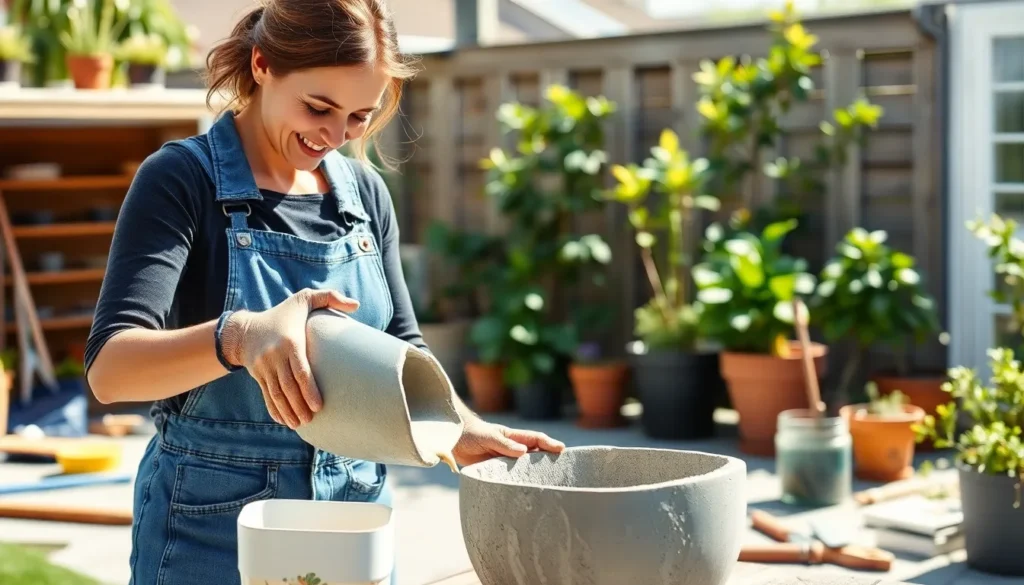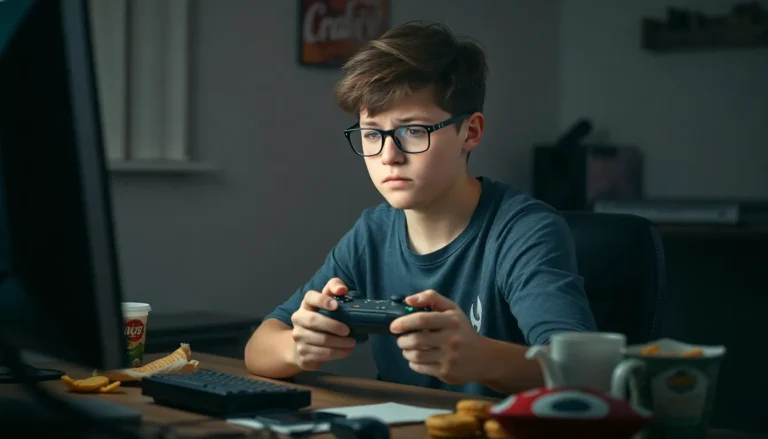Table of Contents
ToggleConcrete might seem like a heavy topic, but it’s about to get a whole lot lighter! Forget the days of dreary gray slabs; with a little creativity and elbow grease, concrete can transform into stunning DIY projects that’ll have friends and family wondering if you’ve secretly hired a professional. From stylish garden planters to sleek countertops, the possibilities are endless—and they don’t require a degree in engineering.
Imagine impressing your guests with a chic concrete coffee table that you whipped up in a weekend. Not only will you save money, but you’ll also have the satisfaction of saying, “Yep, I made that!” So grab your gloves and get ready to unleash your inner architect. Concrete DIY projects are not just practical; they’re fun, fulfilling, and a fantastic way to add a personal touch to your home.
Overview of Concrete DIY Projects
Concrete serves as a versatile medium in numerous DIY projects. Homeowners can create anything from simple garden decor to intricate furniture pieces. Popular projects include planters, countertops, and statement pieces that elevate interior spaces.
Planters made from concrete add a modern touch. They not only provide a sturdy option for outdoor plants but also complement various design aesthetics. Coffee tables crafted from concrete offer durability while showcasing unique shapes and finishes.
For those seeking functionality, concrete countertops stand out. These surfaces deliver a sleek look and withstand daily use. Additionally, DIY enthusiasts can cast shelves that blend style with utility.
Tools and materials required for concrete projects typically include mixing tubs, molds, and basic hand tools. Choosing the right type of concrete, whether quick-setting or standard mix, influences the outcome. Proper mixing techniques ensure a smooth consistency, leading to successful results.
Finishing touches matter as well. Painting, staining, or sealing concrete enhances visual appeal and prolongs durability. Each technique offers different aesthetics and protection levels, allowing for personalization.
Overall, engaging in concrete DIY projects fosters creativity. Individuals can transform ordinary materials into distinctive home accents. A hands-on approach not only personalizes spaces but also reflects individual styles and preferences.
Benefits of Concrete DIY Projects

Concrete DIY projects offer numerous advantages, making them a worthwhile investment for home improvement enthusiasts.
Durability and Longevity
Durability stands out as one of the primary benefits of concrete. This material withstands various weather conditions, ensuring projects remain intact over time. Indoor or outdoor, well-crafted concrete pieces resist wear, making them ideal for garden décor and furniture. Longevity also plays a crucial role in appealing to many DIY enthusiasts. Once properly cured, concrete items can last for decades with minimal maintenance. Many people appreciate the reliability of concrete, considering it an excellent choice for durable home accents.
Cost-Effectiveness
Cost-effectiveness marks another significant advantage of concrete DIY projects. Utilizing concrete often results in lower expenses compared to purchasing ready-made furniture or decorations. Homeowners can create custom items tailored to their style without spending excessively. DIY projects eliminate labor costs associated with hiring professionals, allowing for greater budget flexibility. Additionally, concrete’s versatility means it’s suitable for a wide range of projects, further extending financial savings. Many find concrete an economical choice while adding uniqueness to their living spaces.
Popular Concrete DIY Project Ideas
Concrete offers a variety of DIY project options that enhance outdoor and indoor spaces. Engaging in these projects transforms concrete from a mundane material into stunning designs.
Garden Pathways
Creating garden pathways adds functionality and visual appeal to outdoor spaces. Simple forms like stepping stones or intricate designs can guide visitors through gardens. Using concrete allows for mixing colors and patterns to match garden themes. While designing pathways, consider incorporating different shapes and sizes of stones for unique layouts. Properly sealed pathways withstand weather elements, ensuring durability. Opt for molds to create various textures, providing a customized look for any garden style.
Concrete Planters
Concrete planters remain popular for their unique aesthetic and durability. Building varied sizes accommodates diverse plant selections, from small succulents to larger shrubs. Decorative techniques like texturing or painting add personality to these planters. Notably, using drainage holes prevents overwatering and promotes plant health. Customized molds allow for creative shapes that enhance the garden’s design. These durable planters withstand time and outdoor conditions, making them a lasting addition to any space.
Outdoor Furniture
Crafting outdoor furniture from concrete delivers both style and resilience. Concrete benches or tables provide sturdy seating and dining options for patios and gardens. Mixing concrete with aggregates can create eye-catching designs and textures. While working on furniture, emphasize comfort and usability by adding cushions or incorporating smooth finishes. This versatility aligns well with various garden themes, whether modern or rustic. Choosing high-quality sealants ensures longevity against the elements, making outdoor furniture an enduring investment.
Tools and Materials Needed
Creating stunning concrete DIY projects requires certain tools and materials. Gathering these essentials ensures a smooth crafting experience.
Essential Tools
Safety gear includes gloves, goggles, and masks, which protect against dust and particles. A mixing tub is crucial for blending concrete evenly. Pouring molds shape the final product, while a trowel helps achieve a smooth finish. Leveling tools ensure projects sit flat and even. Measuring cups promote accuracy in mixing ratios, and a drill with mixing attachment simplifies the process. Finally, concrete sealer and brushes enhance durability and aesthetics.
Recommended Materials
Choosing the right type of concrete is essential. For decorative projects, lightweight concrete offers ease of handling. Ready-mix concrete simplifies the process by eliminating the need for standalone materials. Adding color pigments allows for personalized designs, while decorative aggregates enhance visual appeal. Reinforcement materials like wire mesh or rebar improve strength and stability. Lastly, a waterproofing agent ensures longevity when crafting outdoor items.
Step-by-Step Guide to a Simple Concrete Project
This guide provides essential steps to create a simple concrete project. It simplifies the process, ensuring even beginners can follow along.
Preparing the Site
Start by selecting a flat, stable surface for your project. Clear debris, grass, or any items that could interfere with the concrete. Use stakes and string to mark the area, outlining the project’s dimensions accurately. Ensure the frame or mold is secure, preventing leaks during pouring. This preparation sets the foundation for a successful pour.
Mixing Concrete
Gather the necessary tools, including a mixing tub, shovel, and water source. Follow the instructions on the concrete mix package for the correct water-to-concrete ratio. Pour the concrete mix into the tub, then gradually add water, mixing thoroughly until a uniform consistency is achieved. Aim for a smooth texture, which ensures an even pour. Consistency is key for optimal strength and durability.
Curing Process
After pouring the concrete, allow it to set for at least 24 to 48 hours. Covering the surface with plastic can help retain moisture. Ensure the concrete remains moist during the curing period, which typically lasts seven days. Maintaining the right moisture levels supports optimal strength development. Check daily to avoid cracks caused by rapid drying. This step is essential for long-lasting concrete projects.
Embracing concrete DIY projects opens up a world of creativity for anyone looking to enhance their home. With the right tools and techniques, transforming concrete into stylish and functional pieces becomes an enjoyable venture. Whether it’s crafting elegant garden planters or durable furniture, the possibilities are endless.
These projects not only allow for personal expression but also offer a cost-effective solution for home decor. By investing time and effort into these creations, individuals can enjoy unique items that stand the test of time. With a little imagination and some hands-on work, concrete can truly become a standout element in any living space.



